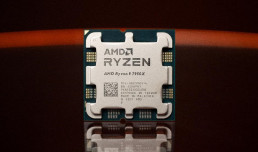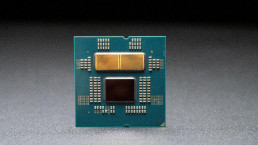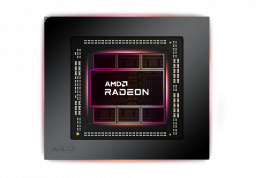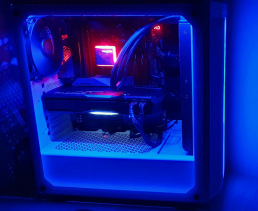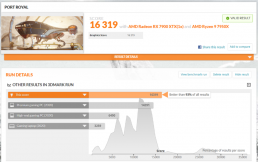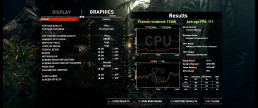AMD made major changes to its CPU and GPU portfolios in 2022. On August 29, AMD unveiled its Ryzen 7000 series of desktop processors powered by Zen 4 architecture and the new socket AM5 platform. These processors have been available globally from September 27. The flagship 16-core AMD Ryzen 9 7950X processor is presently offered at the manufacturer’s suggested retail price (MSRP) of $699.
On November 3, AMD unveiled the Radeon RX 7900 series of graphics cards powered by RDNA 3 architecture. The cards have been available on AMD’s website from December 13, 2022. Leading AMD board partners, including ASRock, ASUS, Biostar, Gigabyte, MSI, PowerColor, Sapphire, Vastarmor, XFX, and Yeston, have offered the cards from mid-December. The Radeon RX 7900 XTX has a starting price of $999, while the AMD Radeon RX 7900 XT has a $899 price tag.
AMD offered samples of the Radeon RX 7900 XTX along with the Ryzen 9 7950X processor, a socket AM5 motherboard, and a DDR5 memory kit. The samples allowed IDC to test how well AMD’s flagship technology platform performed as a completely new system or upgrade over an existing system. IDC also gauged how well the new samples performed over prior generations in terms of performance per watt and computations per U.S. dollar.
What’s New with the AMD Ryzen 7000 Series Desktop CPUs?
The core compute die of the Ryzen 7000 series processor is built on TSMC’s 5nm process node. The input/output die — which now includes basic RDNA 2 graphics capabilities for 2D workloads or diagnostic/troubleshooting purposes — is based on TSMC’s 6nm process.
AMD made a significant change by moving from the previously long-lived AM4 socket platform to the new LGA AM5 socket. Since pins have moved from the CPU to the socket, there is less risk of damage during installations or upgrades. The AM5 platform also supports dual-channel DDR5 memory up to 5200 megatransfers per second (MT/S), in line with JEDEC standards.
AMD has invested in a memory configuration standard it has branded EXPO. EXPO supports advanced pre-configured profile settings designed specifically for AMD memory controllers built into DIMM boards. These pre-configured profiles simplify overclocking for greater bandwidth and tighten timing for the fastest responses and lowest latencies.
The new socket AM5 motherboards have up to 24 PCIe 5.0 lanes and are available with AMD X670E chipsets. In addition to possessing the highest overclocking capabilities, the enthusiast-grade X670 and B650E motherboards support the PCIe 5.0 standard for graphics and storage components. However, PCIe 5.0 support is an optional feature on the mainstream B650 motherboard.
AMD has pledged to support AM5 motherboards through 2025 and at least two subsequent CPU generations. However, support may be provided even longer if the long history of the AM4 series is anything to go by.
What’s New with the AMD Radeon RX 7900 Series GPUs?
The AMD Radeon RX 7900 XTX and Radeon RX 7900 XT graphics cards are the first gaming cards to feature an advanced chiplet design. Like the Ryzen 7000 series, the AMD RDNA 3 generation architecture’s chiplet design combines 5nm and 6nm process nodes. The main graphics compute die (GCD) is built on TSMC’s 5nm process and provides the compute units for rasterization and ray tracing. AMD includes up to six TSMC 6nm memory cache dies (MCDs), each with 16MB of second-generation AMD Infinity Cache technology and a 64-bit wide memory interface. AMD invested in a novel interconnect to link the GCD and MCD chiplets together, enabling bandwidth of up to 5.3TB/s.
The AMD Radeon RX 7900 XTX has 96 compute units. Each has four texture units (for 384 in total), one ray accelerator (96 total), and two artificial intelligence (AI) units (192 total). According to AMD, the performance of the ray tracing units in RDNA 3 architecture is nearly double that of the corresponding units in RDNA 2, while the new AI instructions are nearly three times as many as those in the previous generation.
The AMD Radeon RX 7900 XTX features six MCDs that support 24GB of GDDR6 memory running at 20Gbps over a 384-bit bus. The Radeon RX 7900 XTX also supports USB-C, DisplayPort 2.1, and HDMI 2.1a connectivity with UHBR 13.5, allowing displays with high refresh rates to be connected (up to 480Hz refresh rates on 4K panels and 165Hz refresh rates on 8K panels). A dual media engine supports simultaneous encode or decode streams up to 8K60 for HEVC, as well as the new AV1 codec.
The Test Platform
The test PC hardware components included the AMD Ryzen 9 7950X processor, the Radeon RX 7900 XTX graphics card, the Gigabyte X670E Aorus Master motherboard, and a G.SKILL Trident Z5 Neo 2x16GB DDR5-6000 EXPO memory kit. The Windows 11 main drive was a 1TB GIGABYTE AORUS NVMe Gen4 solid-state drive.
A be quiet! Silent Loop 2 280mm water cooler was installed for the processor, which was paired with a be quiet! STRAIGHT POWER 11 Platinum 850W power supply. A 34″ Dell Gaming S3422DWG monitor — a Quad-HD 3440×1440 display with a 144Hz refresh rate, FreeSync, 10-bit colors, and high dynamic range support — was also utilized.
The reviewer utilized the motherboard’s optimal default settings, set the memory profile to EXPO 6000, and made sure that smart access memory was enabled. No special tuning, optimization, or overclocking was carried out for the tests.
Synthetic Benchmarks and Productivity Performance
PCMark 10 is a comprehensive benchmarking tool that covers the wide variety of tasks performed in the modern workplace. Web browsing, videoconferencing, spreadsheet and word-processing workloads, photo and video editing, and rendering and visualization are some of the tasks tested by PCMark 10.
The gaming test focused on real-time graphics and physics engines of the platform hardware. The 9,186 score the platform achieved was better than 99% of all results produced by PCMark 10.
Blender Benchmark 3.4.0 was used to test the rendering performance of the graphics card. Thanks to the Heterogeneous Interface for Portability — AMD’s compute language for GPUs which Blender Benchmark uses (in contrast to OpenCL, which does not) — the Radeon RX 7900 XTX ranked in the top 10% of all benchmarks, delivering an excellent result.
IndigoBench, an OpenCL benchmark based on Indigo 4’s advanced rendering engine, was used to measure the performance of the Radeon RX 7900 XTX. The AMD Radeon RX 7900 XTX achieved 21.500 M samples/s in the bedroom rendering test and 49.599 M samples/s in the supercar rendering test. According to the published test results, the graphics card was 56% faster than the Radeon Pro W6800 and 51% faster than the 6900 XT.
3DMark Port Royal is a dedicated real-time ray tracing benchmark for gamers. The system’s score of 16,319 was better than 93% of all results and almost double the 8,784 score of the older AMD Ryzen 9 5900X and Radeon RX 6800 XT system.
The system’s 3DMark Time Spy Extreme 4K score of 14,242 was better than 95% of all results. The graphics score of 14,593 was 48% higher than what was achieved by the AMD Radeon RX 6800 XT on the same Ryzen 9 7950X platform.
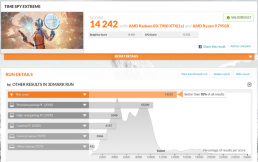
Gaming Performance
Various old and new video games were tested on the platform, including next-gen versions.
Shadow of the Tomb Raider
This game ran at an average 111 frames per second (fps) at 1440p, registering a minimum of 79fps. The highest graphical settings, as well as AMD’s FidelityFX CAS package, were enabled.
FARCRY6
Far Cry 6 ran at an average 140fps at 1440p, registering a minimum of 123fps. All DirectX Raytracing (DXR) and FidelityFX Super Resolution (FSR) features were enabled during testing.
Cyberpunk 2077
Cyberpunk 2077 ran at an average 67fps at 1440p, registering a minimum of 49fps. Ultra-ray tracing presets and FSR 2.1 features were automatically enabled.
The Witcher 3 Wild Hunt Next-Gen
The Witcher 3 Wild Hunt Next-Gen ran at an average 75fps at 1440p, registering a minimum of 60fps. Ultra-ray tracing presets and FSR 2.1 features were automatically enabled.
Fortnite
The latest Fortnite game runs on Unreal Engine 5.1 and makes use of several next-gen features (such as Nanite, Lumen, Virtual Shadow Maps, and Temporal Super Resolution). For example, the Lumen Global Illumination and Lumen Reflection features can exploit the Radeon GPU’s hardware-accelerated ray-tracing capabilities. The updated game ran at an average 82fps, with a 65fps minimum.
IDC Opinion and Conclusion
Ryzen 7950X Performance, Power Consumption, and Heat Considerations
With the Ryzen 7000 generation of desktop CPUs, AMD has taken a new approach to delivering maximum performance. Rather than limit power, AMD allows its CPUs to consume as much power as needed within the socket and reach their thermal throttling temperature (for the Ryzen 9 7950x, the throttling temperature is 95°C). With a much higher CPU thermal design power of 170W in comparison to 105W for the Ryzen 9 5950X, the 7950X reached much higher single threads and all core boost clocks, increasing overall performance and speeding up challenging productivity tasks.
However, enhanced cooling is needed to maintain the performance of the processor (this means increased fan noise). The system and cooler’s fans will quickly ramp up to high speeds when the processor is executing a demanding workload.
AMD provides several tools for performance and efficiency customizations. For example, Precision Boost Overdrive (PBO) is a feature that has dramatic impacts on power consumption, heat, and noise as it enables users to set overall socket power. On the test system, PBO had a major impact on the power consumption of the Ryzen 9 7950X, with only minimal drawbacks in terms of performance.
For example, the Ryzen 9 7950X running at 105W delivered 93% of the performance and used just 46% of the power of a higher 230W system setting. When AMD’s suggested 65W “eco mode” setting was used, the test platform delivered 73% of the performance and used 38% of the power of the 230W setting. While this configuration flexibility is a welcome change, AMD should make it simple and easy for users to change PBO socket power profiles on the fly. AMD could work with Microsoft to enable this capability via the power management features of Windows 10 or 11.
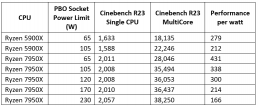
Radeon RX 7900 XTX Considerations
On the GPU side, AMD has increased the GPU power draw to 355W. This is a 55W increase over the 300W draw of the Radeon RX 6900 XT and RX 6800 XT but only a 20W increase over the Radeon RX 6950 XT. Overclocking delivered small gains of around 200 points in 3DMARK tests and slightly boosted gaming fps, but at the expense of increased power consumption, heat, and fan noise. The RDNA 3-based Radeon RX 7900 XTX can hit frequencies of up to 3GHz, with additional power available on AIB partner cards that include a third 8-pin PCIe power connector and significantly enhanced cooling systems compared to AMD reference card designs.
As with the Ryzen 9 7950X, reducing the GPU power limit and undervolting the graphics card significantly reduces overall temperatures and noise for only a few percentage drops in gaming performance.
AMD Ryzen 7000 Series Pricing
AMD faced some criticism about the Ryzen 7000X series and AM5 platform at launch. Although the pricing of the CPUs was competitive, the initial AM5 motherboards based on the X670E chipset were limited in choice and very expensive. This was compounded by the high price of DDR5 RAM (in comparison to DDR4).
AMD has since lowered the price of the Ryzen 7000X and introduced more cost effective and lower power non-X series of CPUs (the 6-core Ryzen 5 7600, 8-core Ryzen 7 7700, and 12-core Ryzen 9 7900). AMD board partners have also introduced a wider range of AM5 motherboards based on the X670, B650E, and B650 chipsets. Volume production of DDR5 has also resulted in more cost-competitive memory options.
AMD Radeon 7900 XTX Pricing
The European street price of the Radeon 7900 XTX is around €1,130, which is higher than the American $999 MSRP listed on amd.com, due to fluctuating exchange rates and taxes (e.g., value-added tax). The cards from board partners are in some cases more expensive, chiefly due to their beefed-up coolers, uprated power systems, and the additional margins of the board manufacturers and their channel partners.
It does not make sense for AMD to lower its profit margins, especially on niche flagship products. AMD’s key competitor asks higher prices for cards in the same category. At the same time, customers may not actually benefit from lower prices in some instances due to intermediaries such as channel partners or scalpers.
It’s getting harder to find a bargain these days, but with an MSRP of $999, the RX 7959 XTX reference card is actually $100 cheaper than the previous generation RX 6950 XT, despite having more compute units, more RAM, a wider RAM interface, and a significantly better performance. This should come as good news for high-end gamers.
User Experience
There are a few user experience challenges with the AMD AM5 platform, some of which are created by partners. For example, updating the motherboard BIOS may be difficult for some users. In fact, updating the BIOS of the motherboard in the test system failed a few times — the reviewer only discovered that the older BIOS first needed to be set to a default state before an upgrade could be made after carrying out a bit of reading and research. Fortunately, new standard features (e.g., BIOS flashback) simplify the recovery process when experiments with settings make a system unbootable and clearing CMOS memory does not work.
Another example is when the reviewer found that when games such as Hell Let Loose, Fortnite or Genshin Impact were launched, a sudden surge in frame rates can dramatically bolster power and voltage consumption. Fortunately, AMD has countered this issue with safety mechanisms that turn the device off when such surges are detected. After carrying out various tests and checking the health of system components, the reviewer found that these problems can be solved by establishing a frame rate cap (e.g., of 240fps), using Radeon Software.
Casual users who encounter such issues may feel displeased with the overall experience, particularly if they have to spend hours troubleshooting with systems integrators or manufacturers. They may attribute the problem to the AMD platform, rather than a poor job from the software house, in capping the frame rates.
AMD Advantage
The AMD Advantage framework combines Ryzen 7950X processors, Radeon RX 7900 XTX graphics cards, the AMD Software: Adrenalin Edition application, and smart technologies to deliver the best experiences to gamers and creators. The company works closely with prominent system integrators, including CSL, Cyberpower, eBuyer, Falcon Northwest, Maingear, Origin PC, and XIdax, to bring stable and enhanced experiences to gamers, streamers, and content creators. Customers who want to avoid the headache of troubleshooting issues during PC buildouts or upgrades will be pleased with AMD’s investments in additional testing, certification, and support.
Performance
AMD is innovating on multiple levels. The company is enhancing core architecture for inter-process communication gains, improving chiplet design for scalable manufacturing, making cache enhancements for memory intensive workloads, and supporting process and design improvements for clock speed increases. As a result of these efforts, its new products are 30–50% faster than previous generations. The company is not holding back or milking the market with small, incremental gains. Competition is one of the biggest drivers of innovation. As such, the performance improvements of AMD CPUs and GPUs are benefiting the entire market.
The move to PCIe 5 and DDR 5 will future proof the new platform. The inclusion of technologies — such as EXPO memory configuration profiles — will make performance improvements simpler and more accessible to the wider PC market.
AMD is also investing in backend software development with ISVs. AMD is collaborating with Adobe, Blender, and OBS to improve hardware acceleration across CPUs and GPUs for content creation, productivity, and encoding, decoding, and streaming use cases, thereby adding productivity value to the gaming cards.
Final Words and Conclusion
According to IDC’s monitor tracker, 1440p is the fastest-growing screen resolution. In addition, 3% of users buy 4K and higher-resolution displays. As these users are the target customers for high-end hardware, AMD is on the right track.
However, AMD has increased the power draw of its CPUs and GPUs to deliver a high level of performance. Per IDC tests, power consumption can be dropped significantly in many cases while still maintaining over 90% of peak performance. In turn, this drop can lower noise and energy bills. AMD can provide users with the best of both worlds by making it simple to switch performance profiles depending on the particular workload.
In conclusion, AMD has certainly taken a big step forward with its new generation of CPUs and GPUs. AMD’s 2023 desktop platform is taking 1440p gaming mainstream and making 120–140Hz refresh rates the norm. The new platform also makes 4K gaming possible at 60fps with the highest graphical settings achievable at native resolutions or with FSR. For this and other reasons, including AMD’s well-earned reputation for remedying challenges and aging very well, we have no issues with recommending the platform.



